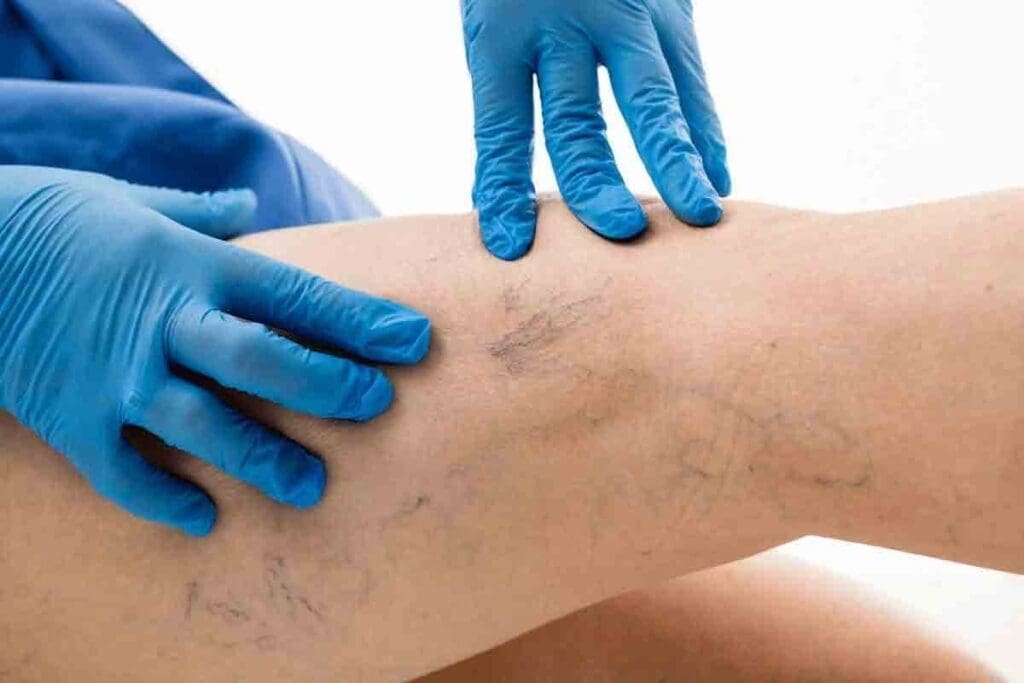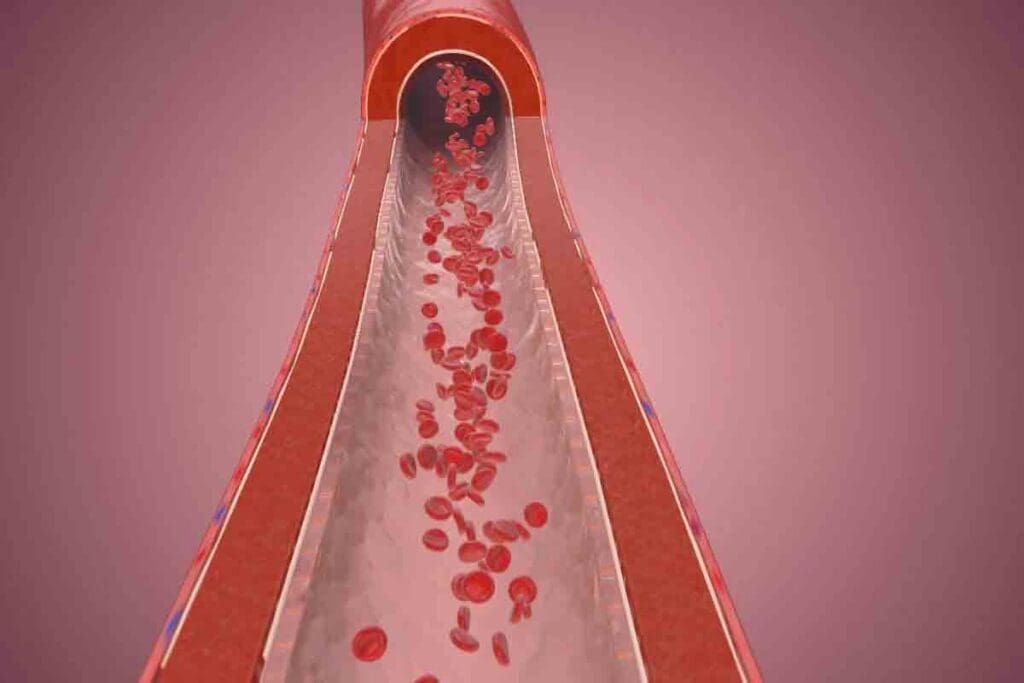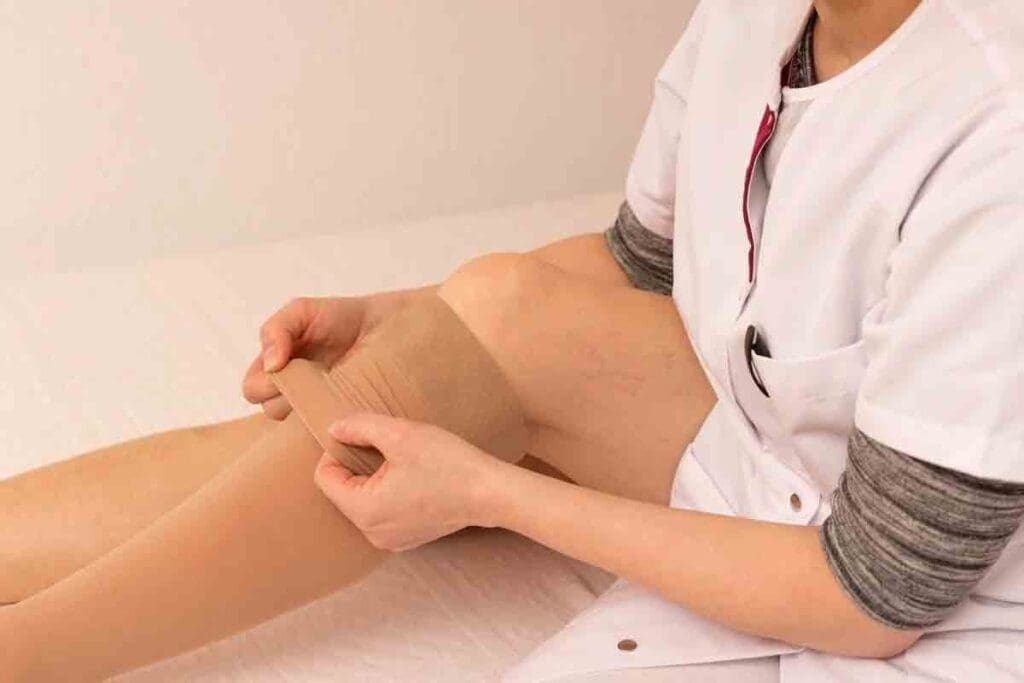Last Updated on November 17, 2025 by Ugurkan Demir

It’s important to know how to check for a blood clot in your leg. A blood clot, or deep vein thrombosis (DVT), forms inside a deep vein of your leg and can cause serious complications if untreated. To check, watch for swelling mainly in one leg, pain or cramping that often starts in the calf, warmth or tenderness when touching the area, and color changes like redness or purplish discoloration. The pain may worsen with walking or standing. Sometimes, visible veins may become swollen or hard. If you notice these signs, seek medical help immediately, as a clot can travel to your lungs, causing a potentially fatal pulmonary embolism. Medical diagnosis often involves ultrasound and other tests to confirm DVT.
Look out for swelling, warmth, redness, and pain in your leg. These symptoms often show up in the calf or back of the leg. At LivHospital, we focus on you, with advanced ways to find and treat blood clots.

Leg blood clots, often linked to deep vein thrombosis, can be very dangerous if not treated quickly. We will look into the key points of this condition. This will help you grasp its risks and signs.
Deep Vein Thrombosis (DVT) happens when a blood clot forms in a deep vein, usually in the lower legs. This is serious because it can cause potentially life-threatening complications. If the clot moves to the lungs, it can cause a pulmonary embolism.
DVT is often caused by slowed blood flow, abnormal clotting, and injury to the blood vessels. Knowing these causes is key to spotting who might be at risk.
Blood clots in the legs form due to several reasons, including:
Knowing these risk factors is vital for preventing and spotting DVT.
Blood clots can form in different parts of the leg, but they most often occur in:
These areas are more likely to have DVT because of the venous system’s anatomy and blood pooling.
By knowing where blood clots usually form, people can watch for symptoms more closely. They should also seek medical help when needed.

Knowing the risk factors helps prevent blood clots. We can lower our risk of Deep Vein Thrombosis (DVT) by understanding what puts us at risk.
Some medical conditions raise the risk of blood clots in the legs. For example, cancer and its treatment can affect blood clotting. This makes it more likely for clots to form. Also, heart disease and diabetes can increase the risk.
Inflammatory diseases, like inflammatory bowel disease, also raise the risk of DVT. People with these conditions should know their increased risk. They should talk to their healthcare provider about preventive measures.
Lifestyle choices greatly affect our risk for blood clots. Smoking damages blood vessel linings, making them more prone to clots. Being overweight or obese also raises the risk due to increased vein pressure in the legs and pelvis.
A sedentary lifestyle increases blood clot risk. Long-distance travel or sitting for long periods can cause blood to pool in the legs. This increases the risk of clot formation.
Having surgery and being hospitalized are big risks for blood clots. Surgery, like hip or knee replacement, can damage veins and lead to clots. Hospital stays often mean long periods of bed rest, which also raises DVT risk.
Hospitals use preventive measures like anticoagulant medications and mechanical compression devices for high-risk patients. It’s important for patients to follow these recommendations. They should also discuss any concerns with their healthcare team.
Learning to check for blood clots in your legs can save lives. We’ll show you how to do it early.
Looking for blood clots is a key first step. Here’s how to do it:
Checking for blood clots isn’t just about looking. You need to touch and feel too. Here’s how:
Be gentle when doing this to avoid causing pain or moving a clot.
Keeping a symptom diary is helpful. It tracks any changes in your condition. Here’s how to use it:
Keeping a consistent diary is important. It helps doctors understand your situation better.
By following these steps, you can watch your health closely. This might help you find blood clots early.
It’s important to know the pain signs of blood clots in the legs. These clots, called Deep Vein Thrombosis (DVT), can cause different kinds of pain. The pain can be mild or very strong.
Pain from a blood clot in the thigh can be constant. It might feel like a cramp or soreness. The pain is often a dull ache or feels heavy in the leg.
Key characteristics of thigh pain due to DVT include:
DVT pain can happen in different parts of the leg. It usually happens in the calf or thigh. The pain’s location often shows where the clot is.
It’s important to remember that DVT pain can be confused with muscle strain or cramps.
DVT pain can change based on movement and rest. The pain usually gets worse when standing or walking. It might feel a bit better when resting or elevating the leg.
| Activity | Effect on DVT Pain |
| Walking or Standing | Pain often worsens |
| Rest or Elevating the Leg | Pain may improve slightly |
Yes, many people can feel DVT sensations. These feelings can be mild or very painful. Knowing these signs is key for early detection.
“Recognizing the subtle signs of DVT, such as pain or swelling, is vital for seeking timely medical attention.”
Understanding the pain patterns and sensations of blood clots in the legs helps identify when to get medical help.
Your legs can show clues about blood clots. We’ll look at visual signs that might mean you have a blood clot. This helps you spot symptoms early.
A blood clot can change your skin color. The area might turn red, purple, or blue because of inflammation and poor blood flow. Sometimes, the skin looks pale or discolored.
Key skin color changes to watch for:
A blood clot can make veins look different. The vein might swell, feel tender, and stand out more. It could even feel hard or like a cord.
Visible vein changes may include:
You can’t see blood clots directly, but their symptoms are noticeable. Swelling, redness, and warmth in one leg are signs of DVT.
Knowing what your legs usually look like helps spot problems. Look for differences in color, swelling, or vein size between your legs.
| Characteristic | Normal Leg Appearance | Abnormal Leg Appearance (Poteial DVT) |
| Skin Color | Uniform, natural skin tone | Red, purple, or pale discoloration |
| Swelling | No unusual swelling | Visible swelling, specially in one leg |
| Vein Appearance | Veins not overly prominent or swollen | Swollen, tender, or hard veins |
Knowing these signs and comparing them to your usual leg look helps you spot blood clot symptoms. If you see these signs, get medical help right away.
A blood clot in the leg can show up in different ways, like swelling, changes in temperature, and skin texture changes. These signs can affect how you move and do daily tasks. We’ll look at these symptoms to help you spot a blood clot.
Swelling is a common sign of a blood clot in the leg. It can happen in the calf, thigh, or the whole leg. You might feel your leg is heavy or tight. Sometimes, the swelling can hurt when you walk or move your leg.
Another sign of a blood clot is a change in skin temperature. The area might feel warmer or cooler than the rest of your skin. This is because of inflammation or changes in blood flow from the clot.
Key points to note:
A swollen foot can be a sign of a blood clot, along with pain or redness. The swelling might get worse after resting or in the evening. Watch for other signs like changes in skin color or visible veins.
Blood clots can also make your skin feel different. It might be more sensitive, tender, or even numb. Sometimes, the skin looks shiny or stretched because of swelling.
Notable changes include:
The location of a blood clot in the leg affects the symptoms. Clots can be in the calf, thigh, or back of the leg. Each spot has its own set of symptoms.
A clot at the back of the leg causes pain and swelling. The pain gets worse when standing or walking. Some people feel a heavy or aching sensation in the back of the leg.
A blood clot in the calf leads to calf pain or tenderness. It also causes swelling and warmth or redness of the skin. The pain gets worse when the foot is flexed or when walking. It’s important to watch for these signs, as calf DVT is dangerous.
Signs of DVT in the calf include swelling, pain, or tenderness not from injury. The skin may turn red or discolored, and feel warm. Veins might also become more visible.
A clot in the upper leg causes pain or tenderness in the thigh. It may also swell. The pain can be mild or very severe. If symptoms don’t go away or get worse, see a doctor.
Knowing the symptoms based on clot location is key for early treatment. If you think you have a blood clot, see a healthcare professional right away.
It’s key to know when to get medical help for blood clots. Being aware of symptoms that need quick action is important.
Some symptoms mean you need to see a doctor right away. These include severe leg pain or swelling, trouble breathing, or chest pain. These could mean a pulmonary embolism. If you see these signs, get medical help fast.
Pulmonary embolism symptoms are serious and can be deadly. They include sudden shortness of breath, a fast heart rate, and chest pain that gets worse with deep breaths. Knowing these signs helps you act fast in an emergency.
Blood clots in the legs can cause serious problems if not treated quickly. It’s important to understand how serious blood clots are. Take action right away if you see warning signs.
Symptoms include swelling, redness, and warmth in the leg. You might also feel pain or tenderness. This pain can get worse when you stand or walk.
Look for swelling and redness in your leg. Check for warmth and tenderness too. Compare both legs to spot any differences.
A blood clot makes the leg look swollen, red, or discolored. The skin feels warm, and veins may show more.
Yes, you might feel pain or discomfort in your leg. This pain can be dull or sharp. It gets worse when you stand or walk.
Risk factors include medical conditions like cancer. Lifestyle factors like smoking are also risks. Situations like post-surgery recovery or hospitalization increase the risk too.
Blood clots in the legs can be very serious. If they break loose and travel to the lungs, it’s a pulmonary embolism. Seek medical help if you have symptoms.
DVT in the calf causes pain or tenderness. You might also see swelling, redness, and warmth in the area.
Yes, a blood clot can cause swelling in the foot. It can also swell the ankle and calf.
Signs include pain or tenderness, swelling, and redness in the upper leg. These are clear signs of a blood clot.
Emergency signs include severe pain or swelling. Difficulty breathing, chest pain, or coughing up blood are also warning signs. Seek help right away if you notice these.
Describes clinical presentation, physical exam findings, and the value and limitations of symptoms alone for diagnosis. Ultrasound is the standard non-invasive diagnostic method.https://www.ncbi.nlm.nih.gov/books/NBK507708/
Subscribe to our e-newsletter to stay informed about the latest innovations in the world of health and exclusive offers!